Hymenokallis: description and features of home care
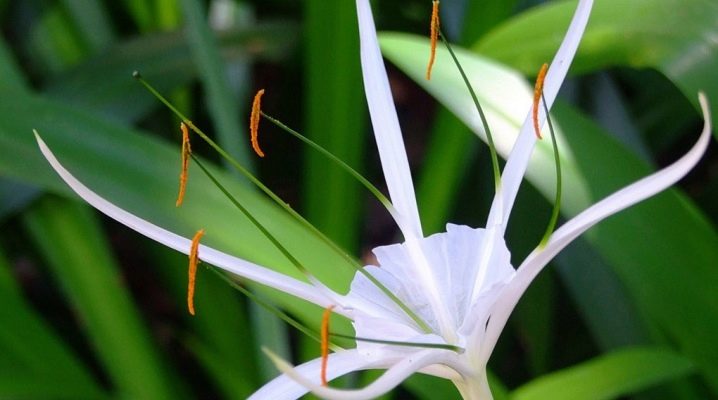
Hymenokallis is an unusual flower that can decorate the landscape of a summer cottage. The bulbous plant native to South America loves river valleys and bodies of water. It attracts flower growers with its unique shape of flowers and the possibility of growing as indoor or greenhouse plants. Let's look at the main nuances of the development and reproduction of this exotic flower at home.
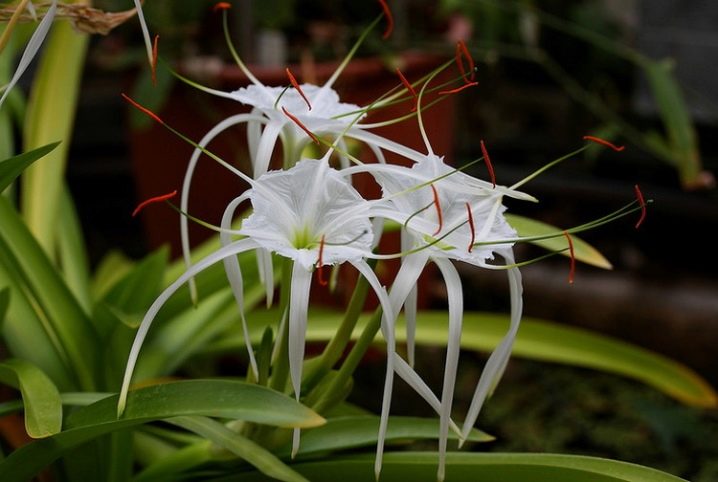
Peculiarities
A distinctive feature of the flower is its adaptability to growth on the shores of fresh water bodies. Cultivated specimens feel good both in the open field and in a pot located on the windowsill of a house or apartment. Depending on the variety, the plant can be either evergreen or traditional, shedding leaves. The flower is picky about light and watering regime.
If hymenokallis is not watered on time, it reacts to the lack of moisture by drying the foliage. The plant is demanding on the composition of the soil, it needs timely transplants, top dressing and is picky about the size of the pots.
Those specimens that are grown at home do not tolerate cold weather, and therefore they need to be protected from freezing. After flowering, it begins a dormant period.


Another nuance of hymenocallis is the toxicity of its juice. If the plant is grown at home, the lily should be placed where neither children nor pets can reach it. Although milk juice is used in moderate doses to treat malaria, puffiness and stretch marks, hymenocallis is not yet fully understood. You can not use it as an emetic or diuretic.
Hymenokallis can be grown in the garden and greenhouse. As for the place for a plant in an apartment or house, you need to consider: an exotic lily will not grow and develop well on the north side. At the same time, on the other sides, it will feel comfortable, even if it is exposed directly to the sun. It is very light-requiring, and therefore in winter, due to the short daylight hours, it needs additional illumination. It is important that in general it is illuminated for at least 10 hours per day.
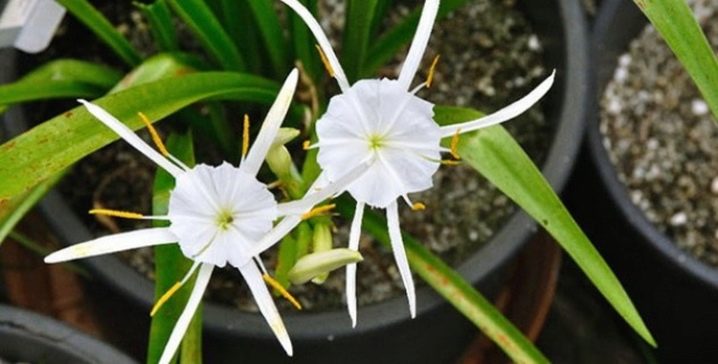
Description
Hymenokallis is considered a herbaceous perennial plant with many names. It is called "Angel Trumpets", "Bride's Basket", "Peruvian Narcissus" and "Spider Lily". Today it has about 60 species, which are divided into separate lines according to their habitat.
An exotic plant has a pear-shaped or egg-shaped bulb, the size of which, depending on the variety and care, can reach 10 cm. In the upper elongated part, the bulb is covered with scales, it has an isthmus that covers the foliage at the roots, collected in a socket.
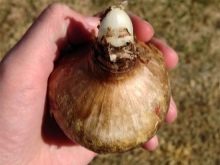
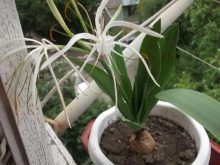
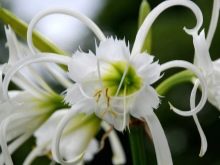
The leaves of the plant are long, xiphoid, dark green (sometimes with an admixture of gray tone), pointed towards the end. In structure, they are quite dense, tend upward, grow in height up to 1 m. Indoor crops, as a rule, are lower and rarely reach half a meter in length. Forcing the shoots themselves from the flower occurs in April, some varieties wither with the onset of autumn.
Hymenokallis flowers are quite unusual. They are collected in inflorescences and are white in color. Their centers are lemon yellow. The lower part of the flower is a single petal, more like a sepal, from which white arrow-petals and orange stamens on long dark green legs tend upwards.Each flower has 6 petals, their length can reach 20 cm.The sepal funnel itself does not exceed 5 cm in diameter.
The inflorescence can consist of a different number of flowers. Depending on the variety, their number varies from 2 to 16. The peduncle can rise from the middle of the leaf bundle to a height of 40-50 cm. After flowering ends, oval-shaped seeds are formed, covered with pulp.

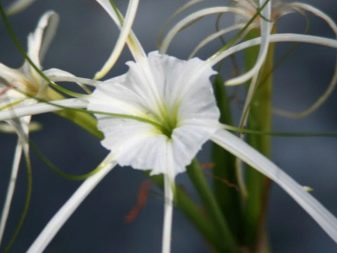
Types and varieties
Despite the fact that today hymenokallis has several dozen varieties, gardeners have their own favorites. Of these, the types presented below are especially popular.
- Coastal belongs to the most easy-to-care types of exotic lilies. It is short, grows up to 40 cm in height, has a pleasant floral aroma. Its flowers are shaped like a spider.

- Caribbean view belongs to the category of evergreen plants. Very susceptible to climate change and loves attention. Differs in yellow anthers, picky about sunlight. It can bloom up to three times a year, for the first time delighting households with arachnid flowers at the end of August.
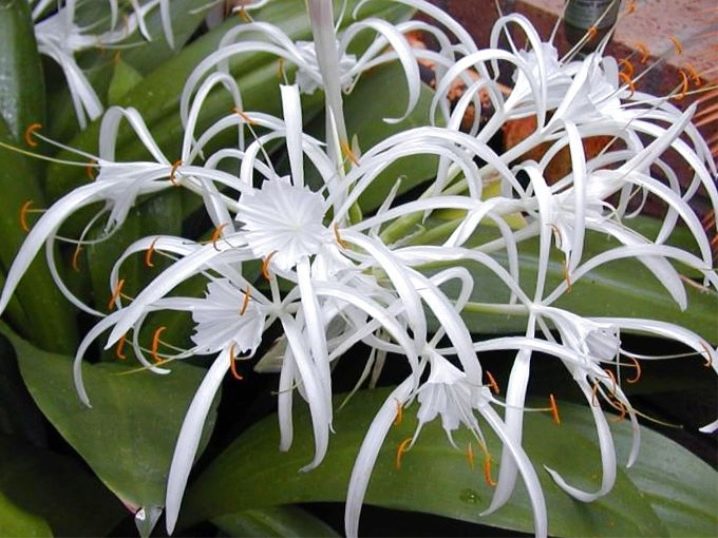
- Beautiful hymenokallis stands out among other varieties in the shape of flowers, which more closely resembles neat umbrellas. Unlike analogues, its peduncle can have up to 12 colors. They smell like a pleasant aroma peculiar to lilies.

- Broadleaf or broadleaf belong to the category of ornamental herbaceous plants. On average, this species is up to 70 cm in height. Flowers differ from other varieties in a more twisted shape of petals. The leaves also have their own difference - they have a pronounced central vein.

- Festalis grown as a garden plant. It is distinguished by the gloss of the foliage, painted in a bright green. The leaves, in comparison with other varieties, are short and do not exceed 40 cm in length.An early species of exotic lily blooms from mid-spring to mid-summer, delighting the gardener with large flowers, 10 cm in diameter.

As for color, in nature you can find varieties of hymenocallis with flowers painted yellow. Varieties may differ in the shape of the flower: somewhere it looks more like a daffodil (for example, cordifolia). In other varieties, flowers practically do not have sepals, it is too small (tubiflora). Other flowers have a large sepal divided into six petals. The long petals at the bottom seem to be the second row of the flower, and the middle is decorated with dark green veins. It is very rare in nature to find varieties with a purple tint of flowers.
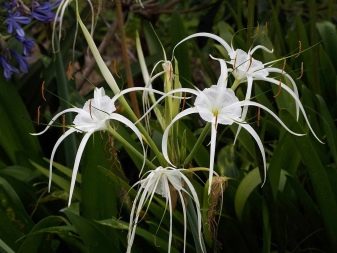
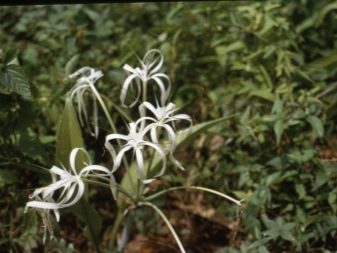
We select the soil and the pot
So that the plant does not hurt during rooting and growth, the choice of substrate must be taken responsibly. The soil must be fertile. You can buy ready-made soil mixture in a specialty store or prepare it yourself. For example, you can mix:
- turf, leafy soil, humus, sand and peat in proportions 2: 2: 2: 1: 1;
- turf, leafy soil and coarse sand in a ratio of 1: 3: 1;
- ready-made soil mixture from the store for bulbous with charcoal.
The plant does not like extra space, but it also does not tolerate tightness. The pot for it must be selected based on the size of the bulb. You can choose this way: when placing the bulb, about 5 cm in diameter should remain to the edges. You should not select a container "for growth", since hymenokallis blooms worse in a too large container. At the bottom of the container, it is worth placing a layer of expanded clay, which will prevent stagnation of water in the root system.
With proper care, flowering usually lasts from March to September.

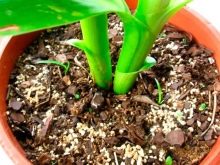
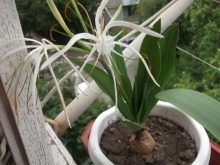
Landing
Unlike other plants, exotic lilies cannot be planted with the bulb completely buried in the ground. It usually goes deep in half, while the top remains open. This is necessary to prevent rotting of the bulb itself. The lily should not be poured with water, as this causes the bulb to rot.
When planting a plant in open ground, the bulb must be germinated. Any container with existing drainage holes is suitable for this. Having placed peat and sawdust in it, the bulb is planted, providing it with comfortable conditions for germination. For example, you can put the container in a cool place where the temperature does not exceed +15 degrees.
To avoid drying out the soil, the container can be placed in a plastic bag, remembering to remove the material to ventilate the plant. Sprouts will not appear if the temperature is less than 10 degrees. You can plant a sprouted bulb in open ground in May, without waiting for the formation of leaves.
It is important to wait for the weather to settle, prepare the soil by digging it up with humus. When planting in open ground, it is necessary to observe the interval between the bulbs equal to 15 cm.



Care
Like any plant, hymenokallis needs attention and basic care rules. Under comfortable conditions, it pleases with the beauty of flowers and freshness of greenery, as well as a pleasant aroma. Caring for him will consist in timely watering, compliance with the temperature regime, humidity level and lighting rules, as well as the planned application of fertilizing, visual inspection and prevention of diseases.
Watering
It is necessary to water the plant regularly and correctly. In no case should you wait for the earth to dry out. The plant needs the soil in the pot to be moist all the time, but not overflowed. At the same time, the abundance of watering depends on the period of flower development. For example, he needs more water during active growth.
It is necessary to reduce watering after the plant has faded. From about mid-October, hydration becomes more metered and not so abundant. During the rest period, watering is minimized. Sometimes the flower is not watered at all at this time.
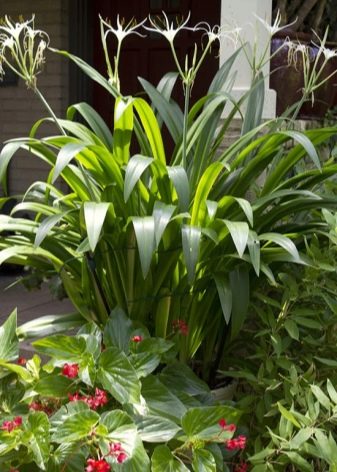

Lighting and temperature control
Speaking of the fact that the plant is not afraid of light, it should be noted: indoor varieties are still not as strong as those that grow on the street. In the heat, you need to remove the flower from the windowsill to prevent possible burns. The temperature for a houseplant in summer corresponds to the temperature of the living room. In winter, it is important that it does not drop below + 14-18 degrees.

Humidity
Hymenokallis does not tolerate dry air. If the room is too hot, it will lead to accelerated evaporation of moisture from the soil. You can put a container of water next to the pot, spray the leaves, or purchase a special air humidifier. During active flowering, you need to carefully compensate for the lack of moisture.
For example, buds cannot be sprayed. For hygiene reasons, you can rinse the leaves in the shower.

Fertilization
In order for the plant to develop well and please with abundant flowering, it is necessary to provide it with timely feeding. It is allowed to feed with mineral fertilizers no more than 1 time in 2 weeks. This will contribute to an increase in the vegetative period, as well as the splendor of the flowers themselves. You can not fertilize with nitrogenous fertilizing, as this inhibits the formation of flowers.
The nutrient solution is prepared in strict accordance with the proportions indicated on the product packaging. Fertilizer must be applied to a moist substrate. When the plant is resting, do not oversaturate the soil with nutrients.
For the entire rest period, he will need only 1 feeding. On average, hymenokallis rests for 3 months.
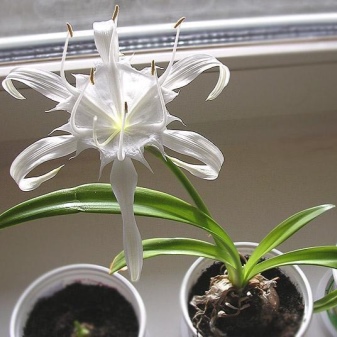

Reproduction and transplantation
You can propagate hymenokallis seeds or bulbous babies. The first method is rather laborious and takes more time. Seeds germinate very slowly, sometimes this process takes up to three months. All this time, you need to ensure that the soil does not dry out. It is also important to ensure that the lily sprouts are not exposed to direct sunlight.
When propagating by bulbs, tubers are taken that are at least 4 years old.Children are separated and planted in a prepared container with drainage.
The transplant of adult lilies can be carried out no more than once every 3-4 years. It is better to spend it during the dormant period, that is, after flowering. It is important to note that the plant does not like to be touched by the bulbs. Given that it can take this painfully, you shouldn't stress it too often.

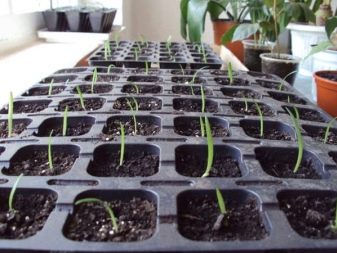
Diseases and pests
In case of violation of the growth and development regime, improper watering, insufficient or excessive illumination, the plant becomes ill. In this case, sometimes it is necessary to change the soil, and the flower itself is treated with special preparations. In addition, the exotic lily can suffer from pest attacks.
- If the roots are rotting, the problem is due to excess water in the soil. In this case, you need to remove the bulb from the ground, get rid of the affected roots, process the sections with ash and "Fundazol". After processing, the lily is planted in a new pot, half covered with fresh substrate.
- Plant damage by aphids or spider mites indicates waterlogging of the soil. To solve this problem, insecticides are used, having previously got rid of parasites mechanically or by removing diseased leaves.
- Staganosporosis (Red Burn) xIt is characterized by the appearance of reddish or blackish spots on the leaves. Here it is necessary to apply "Fundazol".
- If brownish spots and black dots appear on the foliage, you will have to immediately get rid of damaged leaves. Anything that remains should be treated with a fungicide.
- With the defeat of hymenokallis with gray rot, the bulbs suffer... In this case, it is important to remove the diseased area from the tuber and treat the cut site with crushed charcoal. If the affected areas are large, it will not be possible to save the plant.
- The plant does not bloom, not only with a lack of light. The reason for this may be both the scarcity of feeding, and an excessively warm wintering.
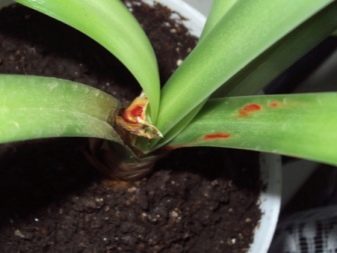
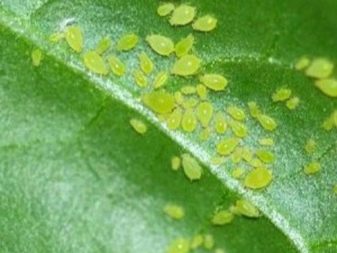
Wintering
If it is warm in the apartment in winter, you will have to artificially create the necessary rest conditions for the plant. The pot, located on the windowsill, can be moved closer to the glass, while not forgetting to fence off the warm air coming from the radiator with plastic wrap. Instead of film, you can use foam or even plastic.
It is worth considering that when used in the winter phytolamp hymenokallis will not be able to "hibernate". It is necessary to bring the plant out of dormancy correctly. Watering begins at the end of February.
In this case, it is preferable to use filtered or settled water at room temperature.


See the video about hymenokallis below.























The comment was sent successfully.